Ap Style Guide Pdf Free Download
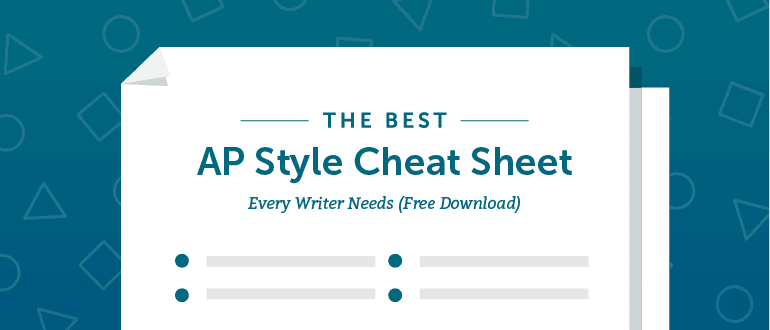
Clarity and consistency are building blocks of great content.
When your writing is crisp, clear, and easy to understand, audiences are more likely to leave your site with a positive impression.
Unfortunately, many brands forego style guides, and choose to wing it instead. This isn't necessarily a fatal mistake by any means. However, it does often lead to content that looks sloppy.
Without guidelines to enforce consistency, it's easy to allow your content to become a formatting free-for-all where commas roam free and nothing follows a clear logic. The results leave your blog or website looking the Wild West of basic grammatical conventions.
If this sounds hyperbolic, consider this: newspapers are written to be as effortless to read as possible. Concise writing and consistent style go a long way toward achieving this goal. There's a reason why your daily paper sounds how it does. It isn't just a stubborn commitment to rules for their own sake.
Does your content need to be perfect to be effective? Not nearly, no. But, everything you can do to enforce consistency and clarity will help your cause.
Before you start learning about AP style, check this out!
Want to improve your writing even more? Check out Actionable Marketing Institute's PR Strategy Certification . You'll get resources & tutorials on how to promote your brand, gain new customers, & grow your business using convincing copy & pitches.
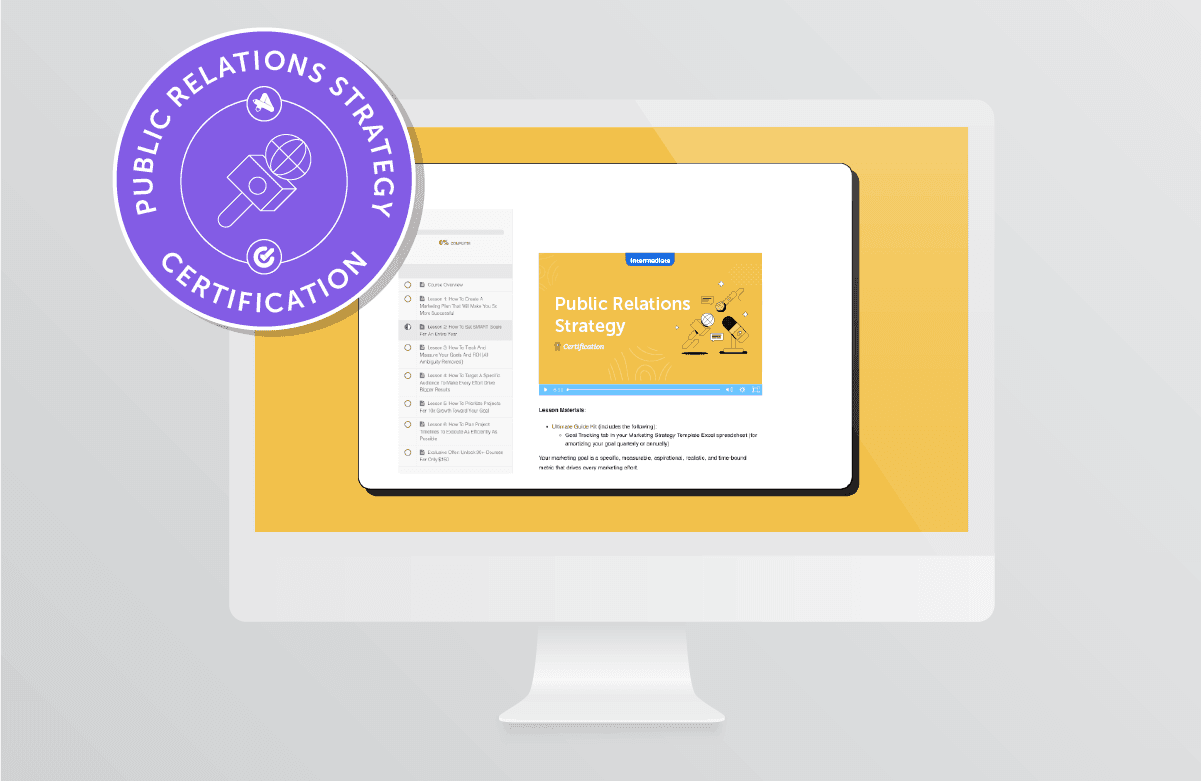
Get all the details.
Table of Contents:
- Free Download
- What is AP Style?
- Who Uses AP Style?
- Ages
- Abbreviations and Acronyms
- Cities
- States
- Dates, Days, Months, Times, and Years
- Datelines
- Numbers
- Sizes, Dimensions, and Distances
- Punctuation
- People's Names
- Hyphens
- Quotes and Quotations
- Technology Terms
- Book, Movie, and Song Titles
- AP Style Checking Tools, Plugins, and Apps
- Bonus Infographic
Download Your Free AP Style Guide Cheat Sheet
If you'd prefer to keep this guide handy in a portable format, you can download the entire thing as a PDF below. This is a good option for reading on tablets, e-readers, or simply keeping on file on your computer.
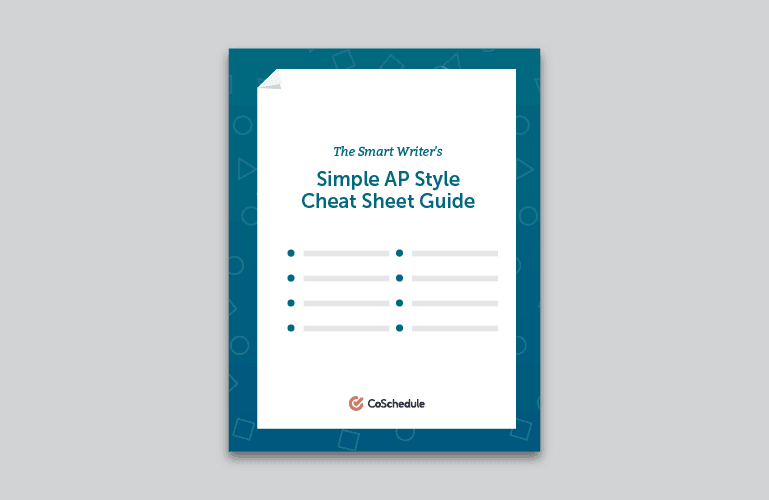
Get Your Download Now
Plus, join our email list to stay up to date.
Success! Your download should start shortly. Or you can download it manually here.
What is AP Style?
The Associated Press Stylebook and Briefing on Media Law official style guide of the Associated Press, a not-for-profit news agency that's been around since 1846. It's often used by news organizations, magazines, and web publications, but brands often use it to form the basis of their own style guides, too.
The official Associated Press style guide gets updated year to year. Here's a look at some changes from back in 2016:
Arguably, these changes have led to bloat. Detractors say the guide is excessively detailed, beyond the point of being necessary, or even useful. This author doesn't disagree with this criticism (hence the creation of this simplified blog post).
If following this specific style is important for your situation, though, consider buying the official version. It's available in both digital and hard copies.
NOTE: It's important not to confuse AP style with APA style.
Who Uses AP Style?
Associated Press style is generally used by journalists, but they aren't alone in using it. Here's a short list of folks who might need to get familiar with it:
- Journalists
- Editors
- PR Professionals
- Marketers
How Do You Denote Ages?
A person's age should always use numerals. When using age as an adjective (using their age to describe an individual), then use hyphens.
Examples:
- The 20-year-old was arrested for underage consumption of an alcoholic beverage.
- At 34-years-old, Larry Fitzgerald remains impressively athletic.
- The five-year-old dog greets its owner every morning.
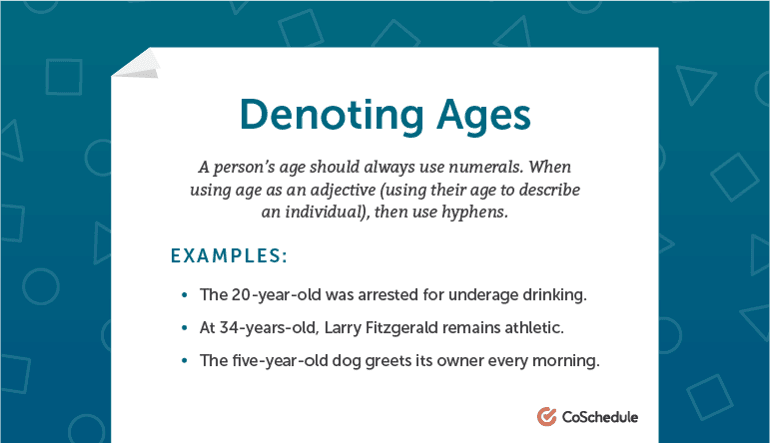
Abbreviations and Acronyms
Use abbreviations for well-known organizations.
Acronyms for Organizations
- Ex: FBI, NASA, IRS, NFL, MLB, NHL, FIFA.
- For other organizations, spell it out on first mention, then use abbreviations for subsequent mentions.
- Use your best judgment. If people are unlikely to understand an abbreviation, then don't use it.
Examples:
- The FBI agent was assigned the case. NASA announced plans to visit Mars.
- The MLB has not announced hot dog price restrictions for this year.
Abbreviations for Formal Titles
Make sure your writing respects people's formal titles. Some examples include political and medical titles. Follow these guidelines:
- Political titles should be abbreviated before full names outside of direct quotes. Examples: Sen. Heidi Heitkamp, Gov. Arnold Schwarzenegger, Rep. John Lewis.
- Medical titles follow similar format: Example: Dr. Michaela Quinn.
Which Cities Stand Alone in AP Style?
Some American cities are considered well-known enough they don't need a state abbreviation. This makes sense, since most people know where they're located. Here's the full list of U.S. cities that fall under this criteria:
- Atlanta
- Baltimore
- Boston
- Chicago
- Cincinnati
- Cleveland
- Dallas
- Denver
- Detroit
- Honolulu
- Houston
- Indianapolis
- Las Vegas
- Los Angeles
- Miami
- Milwaukee
- Minneapolis
- New Orleans
- New York
- Oklahoma City
- Philadelphia
- Phoenix
- Pittsburgh
- St. Louis
- Salt Lake City
- San Antonio
- San Diego
- San Francisco
- Seattle
- Washington
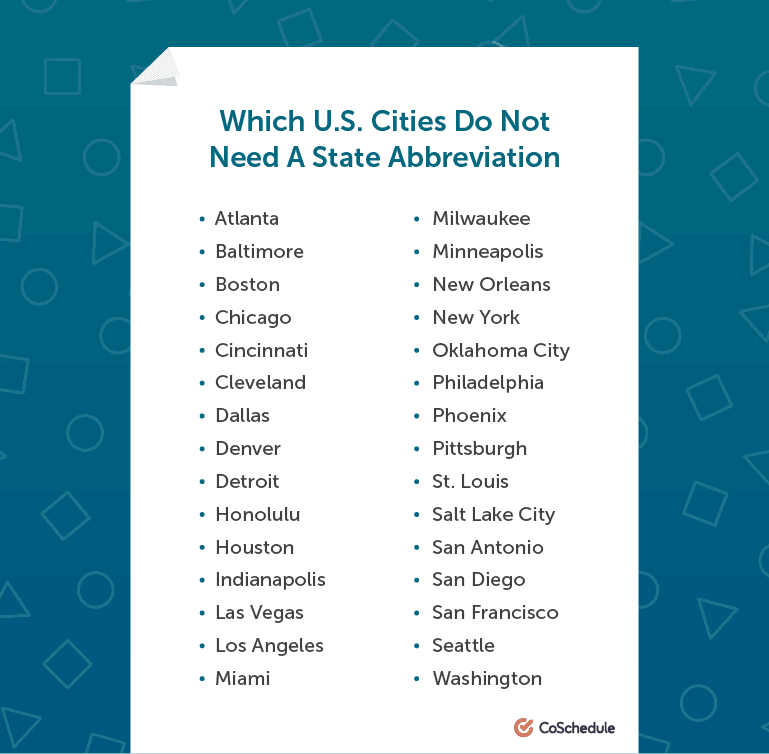
The same goes for the following international cities and country abbreviations:
- Amsterdam
- Baghdad
- Bangkok
- Beijing
- Beirut
- Berlin
- Brussels
- Cairo
- Djibouti
- Dublin
- Geneva
- Gibraltar
- Guatemala City
- Havana
- Helsinki
- Hong Kong
- Islamabad
- Mexico City
- Milan
- Monaco
- Montreal
- Moscow
- Munich
- New Delhi
- Panama City
- Paris
- Prague
- Quebec City
- Rio De Janeiro
- Rome
- San Marino
- Sao Paulo
- Shanghai
- Singapore
- Istanbul
- Jerusalem
- Johannesburg
- Kuwait City
- London
- Luxembourg
- Macau
- Madrid
- Stockholm
- Sydney
- Tokyo
- Toronto
- Vatican City
- Vienna
- Zurich
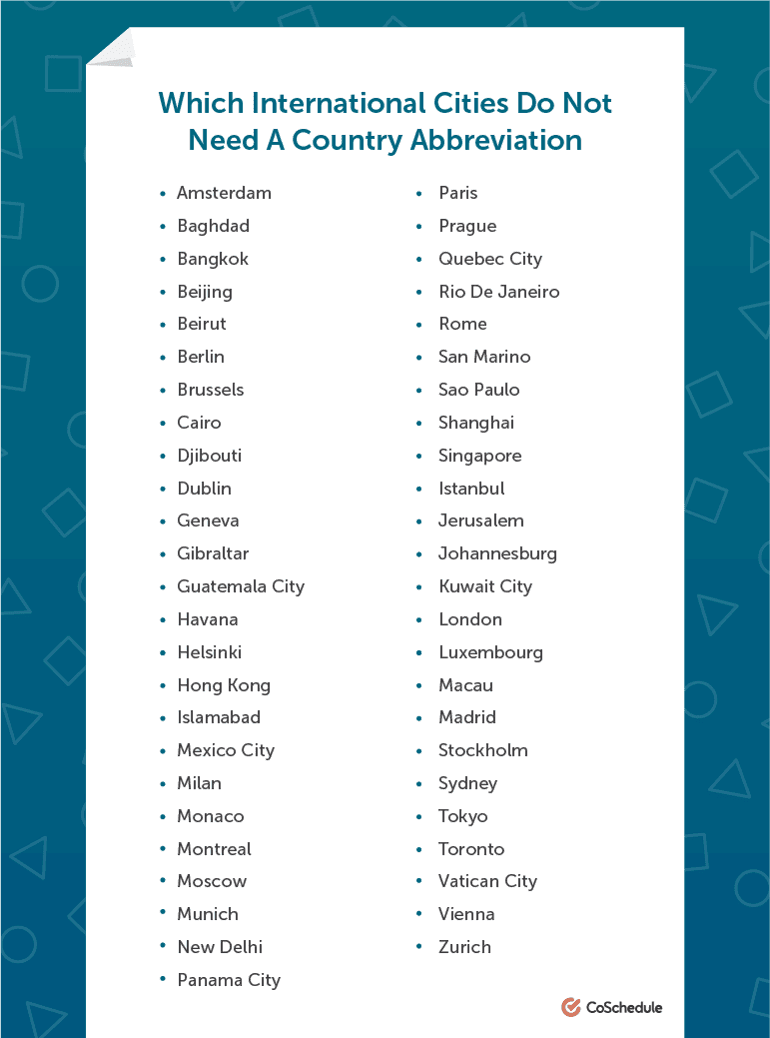
How to Format State Abbreviations
Every state in the United States has a specific abbreviation. Some of these may not seem obvious. Follow this list to get them right.
- Alabama: Ala.
- Arizona: Ariz.
- Arkansas: Ark.
- California: Calif.
- Colorado: Colo.
- Connecticut: Conn.
- Delaware: Del.
- Florida: Fla.
- Georgia: Ga.
- Illinois: Ill.
- Indiana: Ind.
- Kansas: Kan.
- Kentucky: Ky.
- Louisiana: La.
- Maryland: Md.
- Massachusetts: Mass.
- Michigan: Mich.
- Minnesota: Minn.
- Mississippi: Miss.
- Missouri: Mo.
- Montana: Mont.
- Nebraska: Neb.
- Nevada: Nev.
- New Hampshire: N.H.
- New Jersey: N.J.
- New Mexico: N.M.
- New York: N.Y.
- North Carolina: N.C.
- North Dakota: N.D.
- Oklahoma: Okla.
- Oregon: Ore.
- Pennsylvania: Pa.
- Rhode Island: R.I.
- South Carolina: S.C.
- South Dakota: S.D.
- Tennessee: Tenn.
- Virginia: Va.
- Vermont: Vt.
- Washington: Wash.
- West Virginia: W. Va.
- Wisconsin: Wis.
- Wyoming: Wyo.
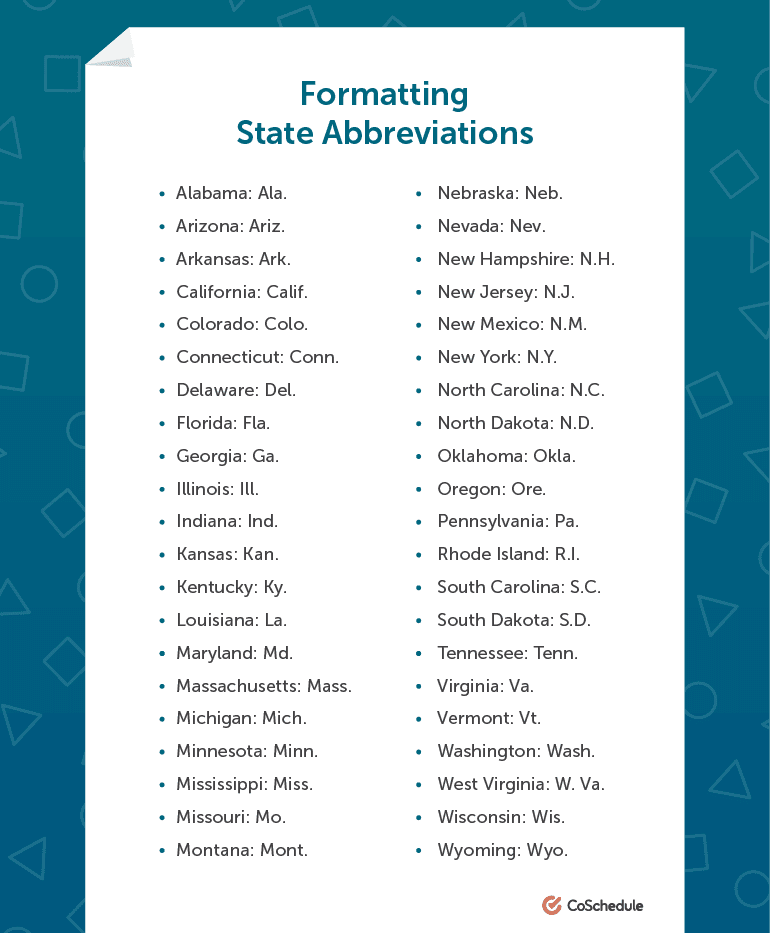
Formatting Dates, Days, Months, Times, and Years in AP Style
Dates and times have a number of formatting considerations.
- Dates: Follow this format: Monday (day), July 1 (month + date), 2018 (year).
- Times: Don't use colons for times on the hour. Ex: 3 p.m., 8:30 a.m.
- Days: Omit st., th., rd., and th. Ex: July 1, not July 1st.
- Months: Abbreviate Jan., Feb., Aug., Sept., Oct., Nov. and Dec. when writing out a specific date. Spell out names of months when not used to indicate a specific date. Ex: Aug. 3, 2018 .
- Years: Use numerals rather than spelling them out. Ex: 2018, not twenty-eighteen.
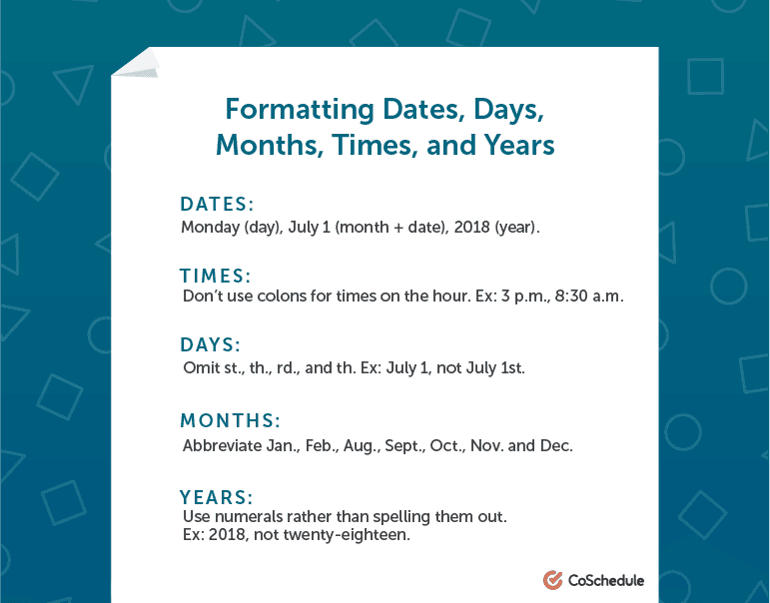
Other Considerations For Dates and Times
- a.m. and p.m. should use periods and lower case letters.
- Never say "yesterday." Use the day of the week instead.
Formatting Datelines
News articles often start with a dateline indicating the location, month, date, and year a story took place. Include city (and state if necessary in the U.S.).
Examples:
- FARGO, N.D. (July, 1, 2018)
- MILWAUKEE (July 1, 2018)
- LONDON (July 1, 2018)
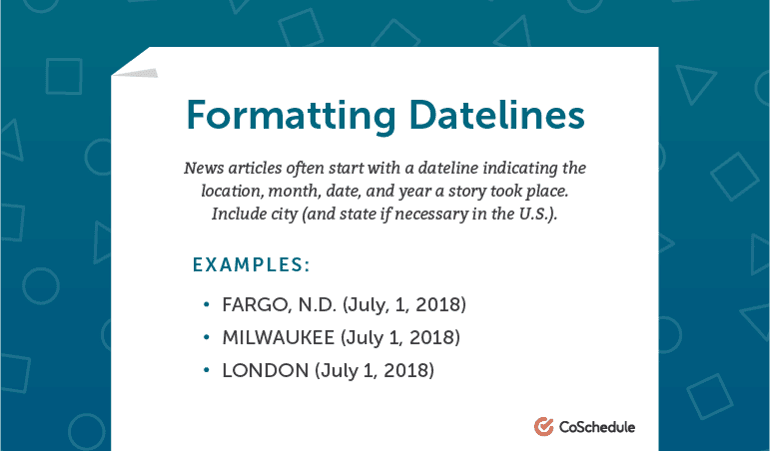
Numbers
Spell out numbers one through nine, and use digits for numbers 10 and higher. The following exceptions, however, should always use digits:
- Addresses
- Ages
- Monetary values.
- Dates and times.
- Sizes and dimensions.
- Percents.
- Speeds.
- Temperatures.
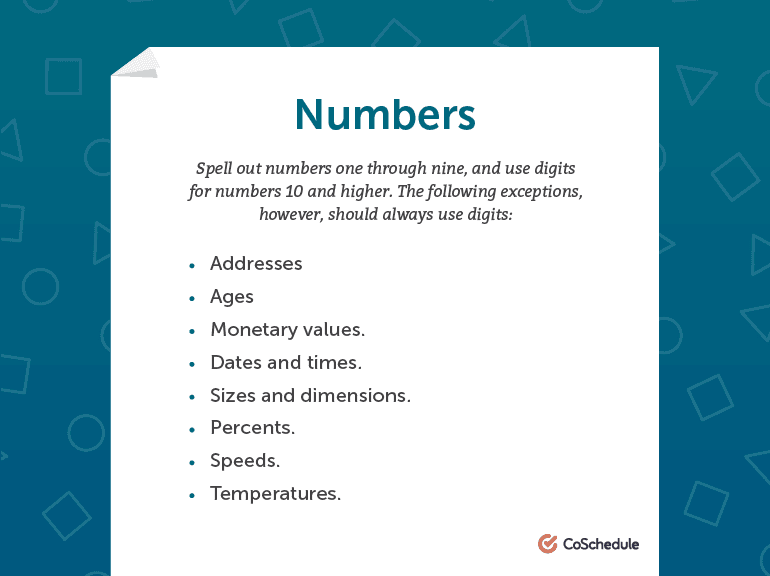
When Should Numerals Be Used?
Use numerals when referring to a sequence of events or people.
Examples:
- Super Bowl XLV
- Queen Elizabeth II
- World War I
What About Percentages?
Always use the full word "percent." The % sign shouldn't be used. That key might feel neglected, but it's okay.
Example: The analyst predicted a 100 percent increase in site traffic.
Sentences Starting With Years
Avoid starting sentences with a number, unless referencing a year.
Example: 1977 was the last year the Minnesota Vikings went to the Super Bowl.
Sizes, Dimensions, and Distances
Sizes and dimensions should use numerals and spell out units of measurement. The same goes for distances.
Examples:
- The party sandwich was 10 feet long.
- The delivery driver traveled 12 miles during harsh weather.
- Bill Smith is 6-foot-5 and plays basketball in his spare time.
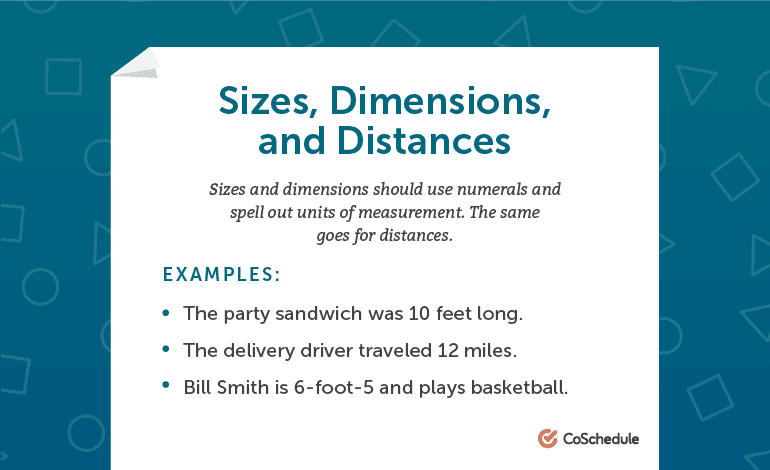
Punctuation in AP Style
You learned everything you needed to know about punctuation in high school English class, right? Well, maybe or maybe not, but this style has quirks of its own to consider.
General Punctuation
Here are some general punctuation guidelines:
- Use a single space after a period.
- Commas should go inside quotation marks.
Serial Commas
In AP style, commas are not included before conjunctions. However, they should be used to separate each item in a list.
Example: I ate a hot dog, pizza slice, burger, and an entire pie.
Using Periods
Lean toward using periods in abbreviations where applicable.
Example: Examples: U.N., M.A., U.S.A.
Singular Nouns Ending in S
When proper nouns end in an S, add an apostrophe at the end.
Example: Sally Jones' red stapler has been stolen.
People's Names
Use their first and last name on first mention. Then, use only their last name on subsequent mentions.
Example: David Johnson is a professional running back. Johnson plays for the Arizona Cardinals.
Using Hyphens Correctly
Use hyphens to connect words in compound adjectives.
Example: The larger-than-life performer juggled seven swords.
Formatting Quotes and Quotations
Here are two points about quotation marks:
- Periods and commas always go within quotation marks.
- Use single quotations for quotes within quotes.
Example: "The candy truck spilled all over the highway," said the driver. "It's a real 'sticky situation' on I-94."
Technology Terms
There are more tech terms and brand names to consider coming out every day. Here's a list of some common ones you may encounter.
- hashtag
- Internet
- Apple "i" products: iPad, iPod, iPhone, iMac, unless the word starts a sentence. Then, capitalize the I.
- e-book
- tweet
- website
- Web page
- YouTube
- social media
- cellphone
- World Wide Web
- Android
- Apple
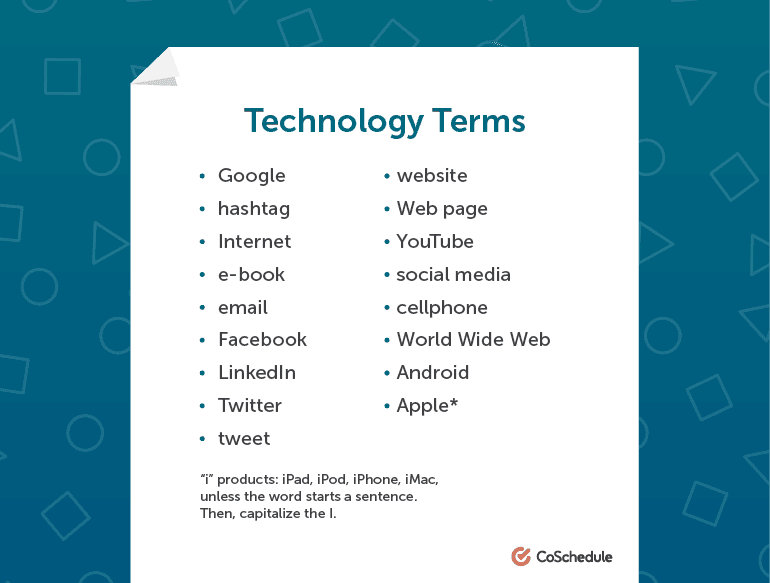
Using Correct AP Style for Book, Movie, and Song Titles
Your favorite author, director, or musician isn't likely to write you an angry letter over incorrect style usage when it comes to their art. An editor probably will, though. Here's how to get it right every time.
Books, Movies, and Song Titles
Use quotation marks rather than italics. This goes against what likely feels right, and how you'd normally format them, but those are the rules.
Examples:
- J.K. Rowling is the author of "Harry Potter and the Sorcerer's Stone."
- "Party in the USA" does not make me feel like partying.
- It turns out that "Total Recall" was not a documentary.

Newspaper, Magazine, and Website Names
Use capitalization but no quotation marks nor italics. This blog post uses italics to highlight examples, so the publication names below have been rendered in normal paragraph text.
Examples:
- The Guardian is a well-respected newspaper.
- Wired is a popular magazine for tech enthusiasts.
- Bob Jones is unsure where his Cat Fancy subscription came from.
Other Considerations
- Capitalize formal titles before people's names.
- Do not capitalize job titles before names.
- Use quotation marks for titles of books, movies, albums, and TV shows.
AP Style Checking Tools, Plugins, and Apps
Keeping all of this information straight can be a hassle (and this post only covers the majority of the most important elements to consider). Fortunately, there are several tools and plugins on the market that can help. Here are some worth checking out:
- AP Style Dates and Times (WordPress Plugin)
- AP Style Guard (Desktop App)
Bonus: AP Style Infographic

You have AP Style down. What's next?
Learn more in-demand public relations skills by joining AMI's Public Relations Strategy Certification . Enroll today to gain access to 12 templates and 12 video tutorials to help you create a robust public relations strategy driven by success.

August 1, 2018
Posted by: lenlenfrancae0272117.blogspot.com
Source: https://coschedule.com/blog/ap-style-cheat-sheet
Post a Comment for "Ap Style Guide Pdf Free Download"